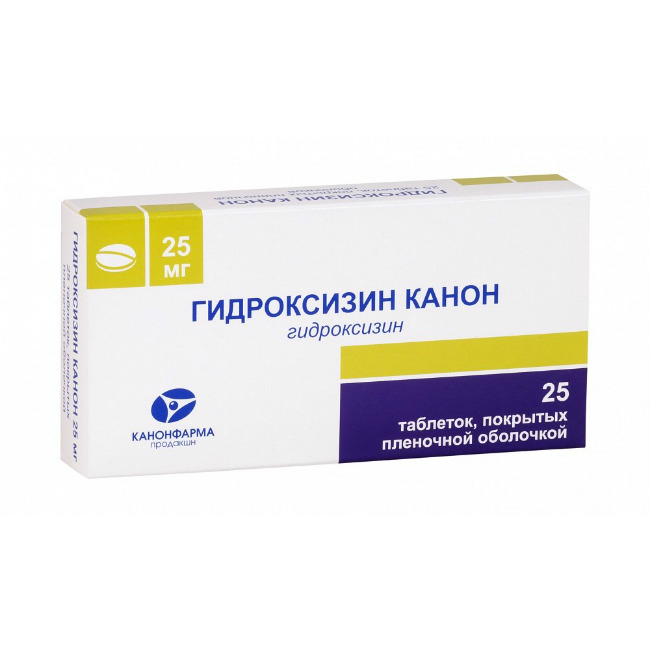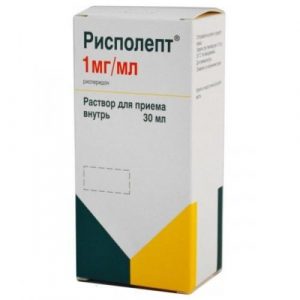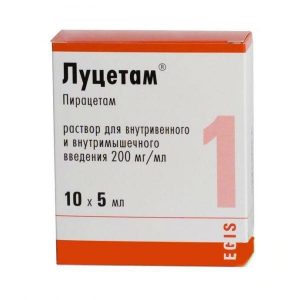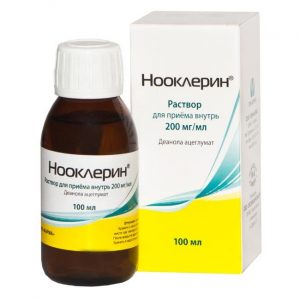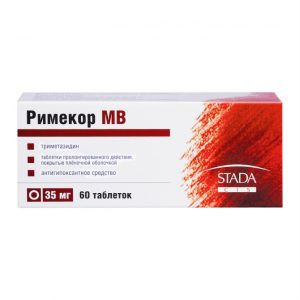Description
Release form
Tablets, film-coated white, round, biconvex, with a risk on the cross section of almost white.
Packing
25 pcs. – blister packagings (1) – packs of cardboard.
Pharmacological action
Pharmacotherapeutic group: anxiolytic agent (tranquilizer)
ATX code: [N05BB01]
Pharmacological properties of
Pharmacodynamics
Hydroxyzine is a blocker of the first generation H1-histamine receptors, a derivative of phenothiazine with antimuscarinic and sedative properties and diphenylmethane, which inhibits the activity of certain subcortical zones.
Has an H1-histamine-blocking, bronchodilating and antiemetic effect, has a moderate inhibitory effect on gastric secretion. Hydroxyzine significantly reduces itching in patients with urticaria, eczema and dermatitis.
Hydroxyzine has a positive effect on cognitive abilities, improves attention and memory. Hydroxyzine is not addictive and mental dependence, with prolonged use of the withdrawal syndrome is not marked. Hydroxysin can inhibit the central nervous system, also has anticholinergic, antihistamine, antispasmodic, local anesthetic, sympathetic effects, has muscle relaxant activity.
In liver failure, the H1-histamine-blocking effect can be prolonged up to 96 hours after a single dose. It has moderate anxiolytic activity.
Polysomnography in patients with insomnia and anxiety shows an increase in the duration of sleep, a decrease in the frequency of nocturnal awakenings after taking once or again hydroxyzine in a dose of 50 mg. A decrease in muscle tension in patients with anxiety was noted when taking the drug at a dose of 50 mg 3 times a day. The H1-histamine-blocking effect occurs approximately 1 hour after taking the tablets inside. Sedation occurs after 30-45 minutes.
Pharmacokinetics.
Suction: Absorption is high. The time to reach maximum concentration (TCmax) after oral administration is 2 hours. After taking an average dose of 50 mg, TCmax in adults is 70 mg / ml.
Distribution: The distribution coefficient is 7-16 L / kg in adults. Hydroxysin crosses the blood-brain barrier and placenta, concentrating more in fetal than in maternal tissues. After oral administration, hydroxyzine penetrates the skin well, while the concentration of hydroxyzine in the skin is much higher than the concentration in the blood serum after both single and multiple doses. The plasma concentration of hydroxyzine does not necessarily reflect its binding to tissues or distribution in skin receptors. It has an effect on skin inflammation depending on serum concentration.
Metabolism: Hydroxyzine is metabolized in the liver. Cetirizine, the main metabolite (45%), is a blocker of H1-histamine receptors. Metabolites are found in breast milk.
Excretion: The half-life (T1 / 2) in adults is 14 hours (range: 7-20 hours). The total clearance of hydroxyzine is 13 ml / min / kg. About 0.8% of hydroxyzine is excreted unchanged through the kidneys. The main metabolite cetirizine is excreted mainly in the urine, also unchanged (25% of the dose of hydroxyzine taken).
Pharmacokinetics in special patient groups.
In elderly patients
In elderly patients, T1 / 2 was 29 hours. The volume of distribution is 22.5 l / kg. A reduction in the daily dose of hydroxyzine is recommended when administered to elderly patients.
Children under 1 year of age
In children, the overall clearance is 2.5 times higher than in adults. The dose should be adjusted. The half-life is 4 hours.
Children 1 to 14 years old
The elimination half-life is 11 hours.
In patients with hepatic insufficiency
In patients with secondary liver dysfunction due to primary biliary cirrhosis, the total clearance was approximately 66% of the value recorded in healthy volunteers. In patients with liver diseases, T1 / 2 increased up to 37 hours, the concentration of metabolites in serum was higher than in young patients with normal liver function. Patients with hepatic insufficiency are recommended to reduce the daily dose or frequency of administration.
In patients with renal failure
The pharmacokinetics of hydroxyzine was studied in 8 patients with severe renal failure (creatinine clearance 24 + 7 ml / min). The duration of exposure to hydroxyzine did not significantly change, while the duration of exposure to cetirizine was increased. In order to avoid any significant accumulation of the cetirizine metabolite after repeated use of hydroxyzine in patients with impaired renal function, the daily dose of hydroxyzine should be reduced.
Indications
Symptomatic treatment of anxiety in adults.
As a sedative during sedation.
Symptomatic treatment of pruritus of allergic origin
Contraindications
Hypersensitivity to any component of the drug, cetirizine and other piperazine derivatives, aminophylline or ethylenediamine
porphyria
children under 3 years of age
pregnancy, childbirth and breastfeeding.
Precautions: for myasthenia gravis, prostate hyperplasia with clinical manifestations, difficulty urinating, constipation, with glaucoma, dementia, convulsive disorders, including epilepsy, with a tendency to arrhythmias, including electrolyte imbalance (hypokalemia, hypomagnesemia), in patients with a history of heart disease (with heart failure and arterial hypertension) or when using drugs that can cause arrhythmia, with hyperthyroidism.
Hydroxyzine helps reduce gastrointestinal motility, the development of stenosing peptic ulcers, respiratory failure.
Use during pregnancy and lactation
The drug Hydroxyzine Canon is contraindicated during pregnancy, during childbirth and breastfeeding.
Special instructions
When used simultaneously with drugs with m-anticholinergic properties and drugs that depress the central nervous system, the dose of hydroxyzine must be reduced.
Hydroxyzine can lead to a prolongation of the QT interval on the electrocardiogram, therefore, simultaneous use with other drugs that can interfere with cardiac activity may increase the risk of arrhythmias. It is assumed that other drugs that cause changes in the electrocardiogram (atropine, antiparkinsonian drugs, lithium carbonate, quinidine, phenothiazines, procainamide, tricyclic antidepressants, thioridazine) can aggravate and exacerbate the changes. which can be caused by hydroxyzine, and increase the risk of sudden death. It is necessary to avoid the simultaneous use of two or more drugs that extend the QT interval, because of the danger of additive effects that can cause the development of potentially life-threatening and severe cardiac arrhythmias.
In cases of renal and / or hepatic insufficiency, doses should be reduced.
In the elderly, the dosage should be selected individually, starting with half the minimum dose, and adjusted in the range of recommended doses. If it is necessary to carry out allergological tests or conduct a methacholine test, the administration of the drug Hydroxysin Canon should be discontinued 5 days before the study to prevent receipt of distorted data.
Alcohol should be avoided during treatment with Hydroxysin Canon.
Influence on the ability to drive vehicles and mechanisms
Hydroxyzine Canon may impair the ability to concentrate and the speed of psychomotor reactions. Taking other sedative drugs may enhance this effect. Therefore, one should refrain from driving vehicles and engaging in other potentially dangerous activities that require an increased concentration of attention and speed of psychomotor reactions.
Composition
1 film-coated tablet contains ::
active substance:
hydroxyzine hydrochloride 25 mg
excipients:
pregelatinized corn starch 30 mg,
silicon dioxide colloidal 0.7 mg,
magnesium stearate 1 mg,
mannitol 40 mg,
microcrystalline cellulose 33.3 mg
film composition:
opadry white: – white: hypromellose (hydroxypropyl methylcellulose) 1.35 mg, hyprolysis (hydroxypropyl cellulose) 1.35 mg, talc 0.8 mg, titanium dioxide 0.5 mg.
Dosage and administration
The drug is administered orally.
Adults:
For the symptomatic treatment of anxiety: a standard dose of 50 mg per day divided into 3 divided doses (1/2 tablet (12.5 mg) in the morning, 1/2 tablet (12.5 mg) in the afternoon and 1 tablet (25 mg at night). In case of anxiety in severe cases, the drug is used in a dose of 50-100 mg 4 times a day.
For symptomatic treatment of pruritus of allergic origin: initial dose 1 tablet (25 mg) at bedtime, if necessary, the dose can be increased to 1 tablet (25 mg) 3-4 times a day.
For sedation in surgical practice: 2-8 tablets (50-200 mg) the night before anesthesia.srdl kp A single maximum dose for an adult should not exceed 8 tablets (200 mg), the maximum daily dose is not more than 12 tablets (300 mg).
For children: For symptomatic treatment of pruritus of allergic origin: Ages 3 to 6 years: 1.0 mg / kg / day to 2.5 mg / kg / day in divided doses.
At the age of 6 years and older: from 1.0 mg / kg / day to 2.0 mg / kg / day in divided doses.
For sedation: 1 mg / kg the night before anesthesia.
The dosage is calculated by the doctor individually depending on the body weight of the child in accordance with the recommended doses, it should be noted that the minimum dosage received, after dividing the tablet, is 12.5 mg.
Use in special patient groups: When used in elderly people, the dose is selected individually taking into account concomitant diseases in the range of recommended doses (see Pharmacokinetics section).
Use in patients with renal failure and impaired liver function:
Dose reduction is necessary for patients with severe and moderate renal failure, as well as with liver failure. In patients with liver failure, it is recommended to reduce the daily dose by 33%. In patients with severe and moderate renal failure, the drug is used in half dose due to a decrease in excretion of the main metabolite of hydroxyzine – cetirizine.
Side effects
Possible side effects are listed below on the body systems and frequency of occurrence.
WHO classification of the incidence of side effects: very often -> 1/10 of the prescriptions (> 10%)
often – from> 1/100 to <1/10 of the prescriptions (> 1% and <10%) infrequently – from> 1 / 1000 to <1/100 appointments (> 0.1% and <1%) rarely – from> 1/10000 to <1/1000 appointments (> 0.01% and <0.1%) very rarely – <1/10000 appointments ( <0.01%) The most common adverse reactions were drowsiness, headache, lethargy, dry mouth and fatigue. Immune System Disorders: Rarely: hypersensitivity is very rare: anaphylactic shock. Disorders of the nervous system: infrequently: dizziness, insomnia, tremor rarely: convulsions, dyskinesia. Mental disorders: infrequently: agitation, confusion rarely: hallucinations, disorientation. Disorders of the organ of vision: rarely: impaired accommodation, impaired vision. Heart abnormalities: rare: tachycardia frequency unknown: prolongation of the QT interval on the electrocardiogram, ventricular tachycardia of the pirouette type. Violation of the vessels: rarely: lowering blood pressure. Disorders of the respiratory system, chest and mediastinal organs: very rarely: bronchospasm. Disorders of the gastrointestinal tract: infrequently: nausea rarely: vomiting, constipation. Disorders from the liver and biliary tract: rarely: impaired functional liver tests frequency unknown: hepatitis. Disorders of the kidneys and urinary tract: rarely: urinary retention. Disorders of the skin and subcutaneous tissue: rare: itching, rash (erythematous, maculopapular), urticaria, dermatitis very rare: angioedema, excessive sweating, acute generalized exanthematous-pustular rash, erythema multiforme syndrome. General disorders: rarely: hyperthermia, malaise. The following side effects were observed with cetirizine, the main metabolite of hydroxyzine: thrombocytopenia, aggression, depression, tic, dystonia, paresthesia, oculogyric crisis, diarrhea, dysuria, enuresis, asthenia, edema, weight gain and can be observed with hydroxyzine. Drug interactions It is necessary to take into account the potentiating effect of hydroxyzine when used together with drugs that inhibit the central nervous system (CNS), such as narcotic analgesics, barbiturates, tranquilizers, sleeping pills, alcohol. In this case, their doses should be selected individually. The simultaneous use of monoamine oxidase inhibitors (MAOs) and anticholinergics should be avoided. The drug inhibits the pressor action of epinephrine and the anticonvulsant activity of phenytoin, and also inhibits the action of betahistine and drugs – cholinesterase inhibitors. It was found that the use of cimetidine in a dose of 600 mg twice a day increases the concentration of hydroxyzine in serum by 36% and reduces the maximum concentration of cetirizine metabolite by 20%. The effect of atropine, belladonna alkaloids, cardiac glycosides, antihypertensive drugs, H2-histamine receptor blockers do not change under the action of hydroxyzine. Hydroxysin is an inhibitor of the CYP2D6 isoenzyme and, in high doses, can cause drug interactions with CYP2D6 substrates. Since hydroxyzine is metabolized in the liver, an increase in its concentration in blood plasma can be expected with simultaneous use with inhibitors of microsomal liver enzymes. Since hydroxyzine is metabolized by alcohol dehydrogenase and the CYP3A4 / 5 isoenzyme, it is possible to increase the concentration of hydroxyzine in the blood plasma while it is used with drugs that potentially inhibit the CYP3A4 / 5 isoenzyme (telithromycin, clarithromycin, delavirdine, somepiconazole azinazoronazole azinazonazole, ketoconazole azone including atazanavir, indinavir, nelfinavir, ritonavir, saquinarin, lopinavir / ritonavir, saquinarin / ritonavir and tipranavir / ritonavir). However, inhibition of one metabolic pathway can be partially compensated by the work of another. The simultaneous use of hydroxyzine with drugs that can potentially cause arrhythmias may increase the risk of lengthening the QT interval and the occurrence of ventricular tachycardia of the pirouette type. The use of the drug simultaneously with agents with an ototoxic effect, such as gentamicin, may mask symptoms of ototoxicity, such as dizziness. The drug should be discontinued 3 days before the planned skin tests with allergens. Overdose CNS toxicity symptoms are associated with excessive m-cholin blocking action, suppression or paradoxical stimulation of the CNS. These symptoms include nausea, vomiting, tachycardia, hyperthermia, drowsiness, impaired pupillary reflex, tremor, confusion or hallucinations. Subsequently, depression of consciousness, breathing, convulsions, decrease in blood pressure, arrhythmia can develop. A worsening of the coma and a cardiopulmonary collapse may occur. Treatment: It is necessary to control the state of the respiratory tract, the state of respiration and circulation through Electrocardiographic (ECG) monitoring, to ensure adequate oxygenation. Cardiac activity and blood pressure should be monitored within 24 hours of the disappearance of symptoms. At high doses, hydroxysin can lead to a prolongation of the QT interval and marked changes in the electrocardiogram. In the case of mental disorders, it is necessary to exclude the use of other drugs or alcohol, if necessary, the patient should be oxygenated, enter naloxone, dextrose (glucose) and thiamine. The use of analeptics is not allowed. Norepinephrine or metaraminol is prescribed for vasopressor effect. Epinephrine should not be used. In case of ingestion of a significant amount of the drug, it is possible to perform gastric lavage with prior endotracheal intubation. Activated carbon may be used, but there is insufficient data to prove its effectiveness. There is no specific antidote. Hemodialysis is not effective. Literary evidence indicates that, in the case of severe, life-threatening, difficult-to-cure m-holinoblocking effects, not dosed with other drugs, it is possible to use a therapeutic dose of physostigmine. Physostigmine should not be used solely to bring a patient to consciousness. If the patient is taking tricyclic antidepressants, the use of physostigmine can trigger seizures and irreversible cardiac arrest. Physostigmine should also be avoided in patients with cardiac conduction abnormalities. Storage Conditions In a dry, dark place at a temperature not exceeding 25 ° C. Keep out of reach of children. shelf life 2 years Deystvuyushtee substance Gidroksizin dosage form tablets Possible product names Hydroxyzine Canon tablets coated film 25 mg 25 pcs. Kanonfarma, Russia
